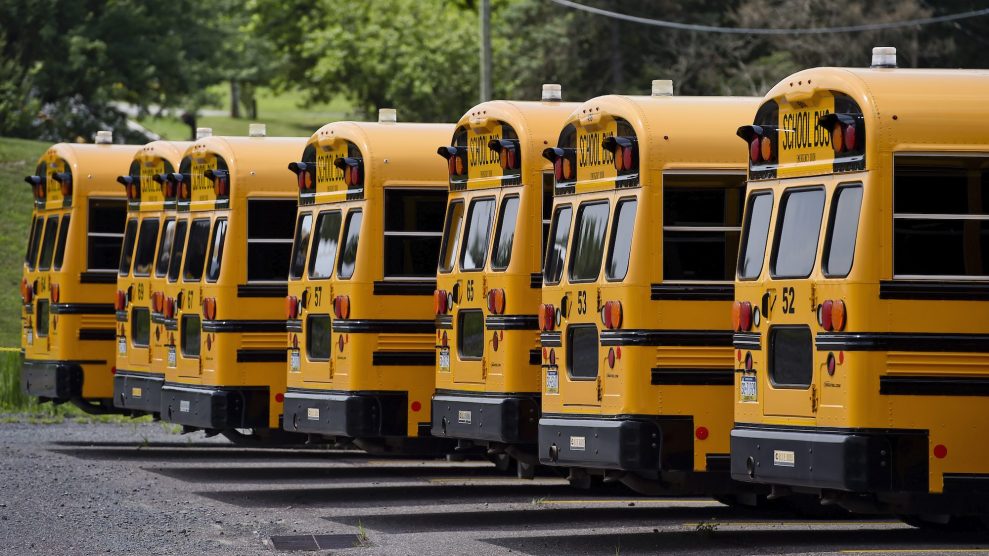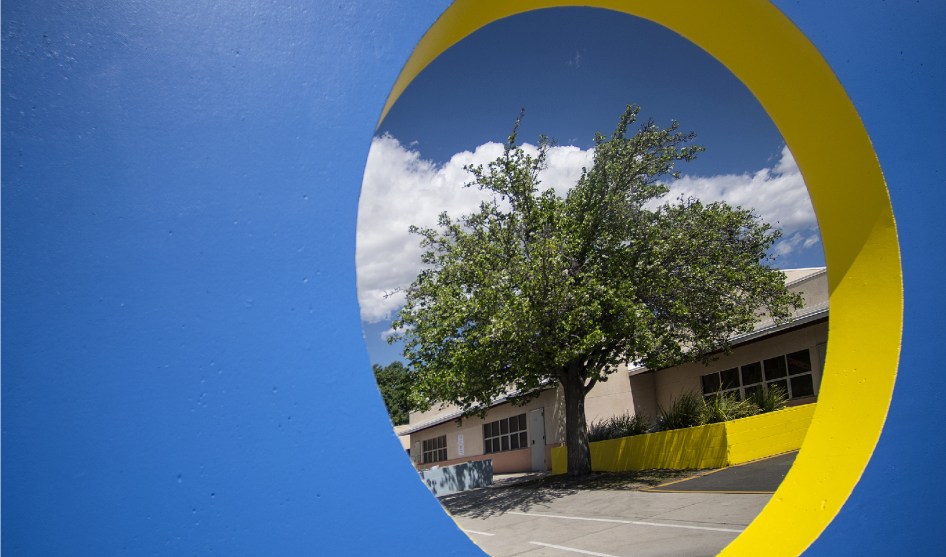
A line of school buses.Ben Hasty/Getty
For the first time in more than 30 years, Kellie Ray, who’s driven school buses in Kentucky, Tennessee, and now Alabama, is feeling the back-to-school blues. Usually, that’s not the case. “I love the kids,” she says with a laugh, “but not the pay.” She calls the middle school children on her route in Shelby County, Alabama, her “babies.”
When Alabama schools reopened last week, Ray saw how everything had changed. Her usual bus route once required picking up about 70 kids, but on her first day back at work, she only drove five. The district, which comprises 21,000 students, divided students into two groups. Those with last names beginning with A through J were going to have in-person instruction on Mondays and Tuesdays, and those whose last names began with K through Z were in classrooms Thursdays and Fridays. According to Ray, until nine days before school started, the plan was to send the entire student body back on the same days. Many families have simply decided to keep students home for completely remote learning.
Ray could see how months of quarantine and anxiety about the coronavirus had affected the children she transported. “They were scared. They didn’t know what to do,” Ray says. “You know how rambunctious they can be. They were all quiet.”
As the pandemic enters its sixth month in the United States, schools have had to grapple with the decision of whether to reopen physically. Many teachers have been outspoken about their concerns. “We don’t believe it is possible for schools to open on September 10,” said Michael Mulgrew, president of New York City’s 200,000-member United Federation of Teachers, in a press conference on Wednesday. “It might be one of the biggest debacles in the history of the city.” But teachers aren’t the only ones who are worried. Schools are complex systems and involve lots of support staff including sanitation workers, cooks, dishwashers, school nurses, and bus drivers. And according to Mark F. Cannizzaro, president of the city’s Council of School Supervisors and Administrators, “vital questions” remain unanswered as districts attempt to sketch out what schools will look like this fall.
One of those basic questions involves the logistics of safely transporting students from home to classroom and back. There are no universal or straightforward answers and lots of conflicting priorities: educating children, supporting school districts’ thousands of staff members, keeping everyone safe, and doing so in a way that doesn’t break budgets. “Even through a lot of adversity, we’re willing and able to go when the time comes,” says Amalgamated Transit Union Local 1181-1061 president Michael Cordiello, who represents about 8,000 school bus workers from various bus companies across New York City’s five boroughs. “After working out safety protocols, I have no doubt that we will rise to the occasion. But I do think time is wasting.”
Driving school buses may not seem like full-time employment; the weekly hours can range from 6 and 10 a.m. to drive children to school, then from 2 to 4:30 p.m. to get them home. Drivers are responsible not just for ferrying children from home to school, but also monitoring them on their trip. Of the 370,000 people employed as school bus drivers, according to AARP, more than 70 percent are older than 55. They’re essential parts of the educational infrastructure, but a disproportionate number of them are of an age that makes them more vulnerable to COVID-19. Through rain or snow or a pandemic, school bus drivers famously rise to the occasion. “Look, our drivers and attendants are professionals,” Cordiello says.
In red states like Georgia, schools have already reopened, with some districts making masks optional. At North Paulding High School, in the northwest corner of the state, where the policy on mask-wearing was a “personal choice,” an image for a hallway of crowded students—few masks in sight—went viral. According to BuzzFeed News, some students and faculty had tested positive before that picture was taken. In one suburban school district, just east of North Paulding, Vox reported that 80 reported cases within the first two weeks of school forced more than 1,100 students, faculty, and workers go to into quarantine.
With potential exposure from numerous children every day, time spent in constrained space, and the reluctance of some school administrations to enforce their own rules, bus drivers are in the intersection of many of the forces at play during the reopening debates. Administrators in Gwinnett County, northeast of Atlanta, announced its bus drivers would begin driving routes last Wednesday. Earlier in the week, a whistleblower email was set up by a state house representative, which revealed that the same administrators were pushing drivers to accept children whether or not they were wearing masks. According to Patch, a Gwinnett County bus driver wrote:
The GCPS Administration has informed us that at the end of August, it’s mandatory for all school bus drivers to transport students whether they have masks or not. We have families, small children, and underlying conditions as well. In addition, a large population of GCPS school bus drivers are over the age of 60, and are highly at risk. This is unacceptable for the GCPS Administration to treat school bus drivers as if we are expendable.
New York City schools are scheduled to reopen for partial in-person learning after Labor Day, with plans to send half the students to school on a given day, with every student coming into class three days a week. That’s a stark contrast from early April, when the pandemic was killing nearly 600 people on a daily basis. And though in many ways the city is a model for recovery, there are serious concerns over the consequences of bringing more than 1 million children back to class. Under normal circumstances, more than 150,000 of those kids rely on school buses.
Bus drivers, along with many other support staff and teachers, complain there is no clear and comprehensive plan. “Quite to the contrary,” says Cordiello, who represents about 8,000 school bus workers across the five boroughs. Negotiations between the city’s department of education and bus contractors whose workers Cordiello represents only began in the last week, and he says, “There has been no conversation up to this point with our union… They haven’t discussed anything with us.” Cordiello is concerned about starting a school year without having considerable safety protocols in place. After COVID-19 first appeared in the city in early March, public schools closed down for the year on 16th of the month. “In that short period of time, we lost 20 members [to COVID-19],” he said. “We’re going to proceed very cautiously.” According to an ATU spokesperson, the city Department of Education is negotiating with bus contractors, but there is no direct line of communication between the department and Local 1181. Instead, the spokesperson said, the Local is dealing directly with the contractors.
“We are in conversations with our labor partners to make sure that proper measures are in place to ensure safety for our drivers, attendants, and our students,” said Danielle Filson, deputy press secretary for the NYC Department of Education.
Come September, New York City buses will require masks, temperature checks, and windows opened for airflow. Students will be seated in every other row to ensure space between each other. Since, in Cordiello’s words, “School buses tend to feel like a test tube for germs,” transportation vehicles will be sanitized daily.
But suppose a child is running a temperature? “If that child is there, without a parent, what do we do?” asks John Costa, president of ATU International, which has more than 200,000 members across bus driving, train operating, baggage handling, and maintenance, including those at Local 1181-1061. “Do we stay there? Do we call another bus to come and take the rest of the children? Is the operator or company going to send somebody to stay with the child until a parent comes?”
The current plan is for buses to run their regular routes, but transport less than 25 percent of their maximum capacity. “A bus of 60 would have 13 to 15 children on it,” Cordiello explains. “That’s as far as that goes.” Initially, bus service would only be offered to children with disabilities before expanding to general population. Theoretically, two buses would be required to cover a route that previously would have been served by only one, potentially adding many hundreds of school buses to the city’s streets.
The CARES Act, passed in late March, contained provisions to keep transportation infrastructure intact even as ridership plummeted, but school buses were not part of the program. Cordiello says that the CARES Act explicitly stated that “transportation for school busing should be continued to the ‘greatest extent practicable’—but those words don’t bind anybody to anything. What’s the greatest extent practicable?”
Though the act made funds available to pay contract workers, Cordiello says the city has turned that option down, while union members faced massive layoffs in the spring. Since May 1, when the city halted payments to school bus contractors, Cordiello describes vehicles sitting in depots, “where they haven’t been maintained, probably not even started,” while “drivers and attendants who’ve been sitting home for five months on unemployment with no medical benefits.” Meanwhile, the Coronavirus Economic Relief for Transportation Services (CERTS) Act, a bipartisan bill introduced in July that intended to pump $10 billion to transportation companies, including bus drivers, has stalled in Congress.
In contrast, Fontana Unified School District in San Bernardino, California, kept district staff members, including drivers, on the payroll through the end of the school year on May 28, even after the district shut down on March 13. That includes the 1,800 members of United Steelworks 8599. Some bus drivers in the district spent the summer delivering meals for a community lunch program—with a five percent pay bump through CARES funding. And thanks to a robust relationship with the school district, Dawn Dooley, president of USW-8599 says unions and schools have worked together since July to devise reopening plans culminating in a district-wide approach called “Navigating the New Normal.”
The result, Dooley says, is that “Fontana has taken the bull by the horns.” Protocols have been established for bus drivers to check temperatures before students climb on. If a student has a temperature above 100.4, a dispatcher brings them home. Like Shelby County, the district has set its sights on a hybrid system, bringing in half the students at time. Once at school, students walk through infrared sensors to check their temperatures again. School isn’t slated to begin until August 24, and students won’t be in classrooms until Fontana is off California’s pandemic watchlist—which gauges regions’ infection rates—for two weeks. Still, “it is very troubling” she says. “You just don’t know, but if you follow the rules, if you wear mask, wash hands, and be conscious of your surroundings, I think you’ll be okay through this.” After all, as Dooley observes, “This is the new normal.”
Back in Alabama, Ray, who knows people who have died from COVID-19, is having a hard time adjusting to the difference in her daily transactions with the kids. Instead of her usual morning smile—impossible behind a mask—she tries to compliment them and “put a smile in their face, something in their head.” But between her mask and face shield, the exchange doesn’t quite work. Plus, she says driving is uncomfortable in Alabama’s late summer heat, which may raise questions about the effectiveness of air circulation inside the bus. Despite it all, Ray tries to stay positive and upbeat for the children she ferries from home to school and back. But it’s hard to shake one uncomfortable feeling. “You know,” she said, “we’re dealing with the End Times.”















